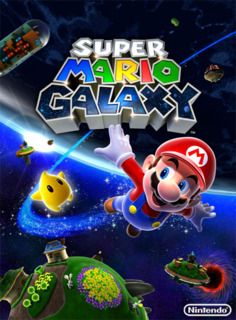Super Mario Galaxy is an astounding platformer in which finding fault is difficult.
Mario receives an invitation from Princess Peach to come to the castle. The Mushroom Kingdom residents are celebrating the annual star festival as Mario arrives. Bowser crashes the party when he flies in on his airship and abducts not only Princess Peach, but her entire castle, and flies off into outer space. Kamek blasts Mario across the sky. Our famed Italian hero awakens to a curious rabbit who splits into three rabbits, and challenges Mario to a game of chase. You will immediately notice the game's exceptional control. Mario runs and jumps much more smoothly than what he did in Super Mario 64 or Super Mario Sunshine.
You will also notice that visually, Super Mario Galaxy looks better than anything else on the Nintendo Wii. Textures are incredibly smooth, character models are stunning, and everything that can be seen has a great touch of detail. The rabbit transforms into a luma after Mario catches it. The little pink fella introduces Mario to its "momma", Princess of the galaxies, Rosalina. You also learn that Bowser has caused trouble among Rosalina and the lumas, and it is Mario's job to find all of the power stars to restore the galaxies.
In the Space Observatory, Mario can enter various little huts that contain stages with power stars. The Space Observatory is quite large, and can be somewhat tedious to navigate, but it is not a hindrance to gameplay. Each world contains three to five stages. The stages range from the elemental such as fire, water, and ice, ghost houses, space junk, and even bee villages. The stages are gorgeous to look at and contain fun challenges.
Challenges range from using various power-ups to defeat certain enemies, retrieve certain items, complete time trials and dare-devil runs, and more. These tasks revolve around the game's gravity bending gameplay. Mario will run across walls, ceilings, large and small planetoids. Hungry lumas appear in some stages, and when fed starbits, the game's currency, retrieved with the Wii-mote pointer, they transform into launch stars that can launch Mario to a new area.
Some cool new power-ups are introduced in Galaxy. The bee suit, spring suit, boo suit and ice flower are a couple of new additions to the series. Using these power-ups are a blast, and many of the game's challenges revolve around these new abilities. The boo suit is probably my favorite. Mario turns into a mustachioed ghost, and shaking the Wii-mote makes him invisible for a brief moment, allowing him to pass through solid walls and fences. Mario retains his superb jump abilities, back-flip, and long jump. Our chubby icon attacks by spinning into an enemy when the player shakes the wii-mote, or by jumping on enemies.
Galaxy's soundtrack is an assimilation of Mario's historic musical past mixed with some great new dazzling pieces. Gusty Garden's music is a great example of a new orchestrated masterpiece, containing sweeping violins and other magical instrumentation. Many old tunes in the series have been re-done and sound better than ever.
Galaxy is a game that every platformer fan needs to experience. The game excels in its gravity-less, space based universe, and is an absolute wonder to look at and hear. Motion controls are kept to a minimum, but when used, they work great. Mario controls flawlessly, and the platforming is graceful. From top to bottom, Super Mario Galaxy is a top-notch video-game, and an exceptional achievement in every way.

